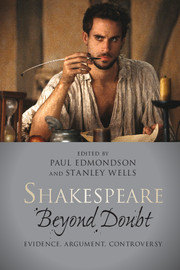Book contents
- Frontmatter
- Content
- List of illustrations
- List of contributors
- General introduction
- Part I Sceptics
- Part II Shakespeare as author
- 6 Theorizing Shakespeare's authorship
- 7 Allusions to Shakespeare to 1642
- 8 Shakespeare as collaborator
- 9 Authorship and the evidence of stylometrics
- 10 What does textual evidence reveal about the author?
- 11 Shakespeare and Warwickshire
- 12 Shakespeare and school
- 13 Shakespeare tells lies
- Part III A cultural phenomenon: Did Shakespeare write Shakespeare?
- Afterword
- A selected reading list
- Notes
- Index
8 - Shakespeare as collaborator
from Part II - Shakespeare as author
Published online by Cambridge University Press: 05 April 2013
- Frontmatter
- Content
- List of illustrations
- List of contributors
- General introduction
- Part I Sceptics
- Part II Shakespeare as author
- 6 Theorizing Shakespeare's authorship
- 7 Allusions to Shakespeare to 1642
- 8 Shakespeare as collaborator
- 9 Authorship and the evidence of stylometrics
- 10 What does textual evidence reveal about the author?
- 11 Shakespeare and Warwickshire
- 12 Shakespeare and school
- 13 Shakespeare tells lies
- Part III A cultural phenomenon: Did Shakespeare write Shakespeare?
- Afterword
- A selected reading list
- Notes
- Index
Summary
If he did collaborate, or used researchers, or perhaps had a wonderful editor, that is interesting and important to me.
Mark RylanceThis essay describes William Shakespeare as a dramatist who worked in collaboration with other writers for the professional theatre. The evidence for this account lies largely in the field of stylistic analysis – typically computational stylistics – whose methodology MacDonald P. Jackson describes elsewhere in this volume (Chapter 9). Some of the conclusions reached by attribution scholarship remain speculative, as will be indicated where this is the case. This is a field of on-going investigation and evolving techniques. But there is nothing speculative about the outlines. The core findings are that Shakespeare collaborated with other dramatists on Titus Andronicus, Henry VI Part Two, Henry VI Part One, Edward III, the revision of Sir Thomas More, Timon of Athens, Pericles, All Is True (Henry VIII) and The Two Noble Kinsmen. Recent attribution studies have suspected his work elsewhere too: in Arden of Faversham, and in the revisions added to The Spanish Tragedy, as first printed in the edition of 1602, and perhaps Mucedorus, as first printed in the edition of 1610. He is also likely to have collaborated in the lost tragicomedy Cardenio, and his sole authorship of Henry VI Part Three has fallen under suspicion. Furthermore, two of his plays, Macbeth and Measure for Measure, were adapted after his death. Shakespeare was a regular collaborator at the beginning and end of his career, and an intermittent collaborator at other stages.
- Type
- Chapter
- Information
- Shakespeare beyond DoubtEvidence, Argument, Controversy, pp. 88 - 99Publisher: Cambridge University PressPrint publication year: 2013
- 1
- Cited by



